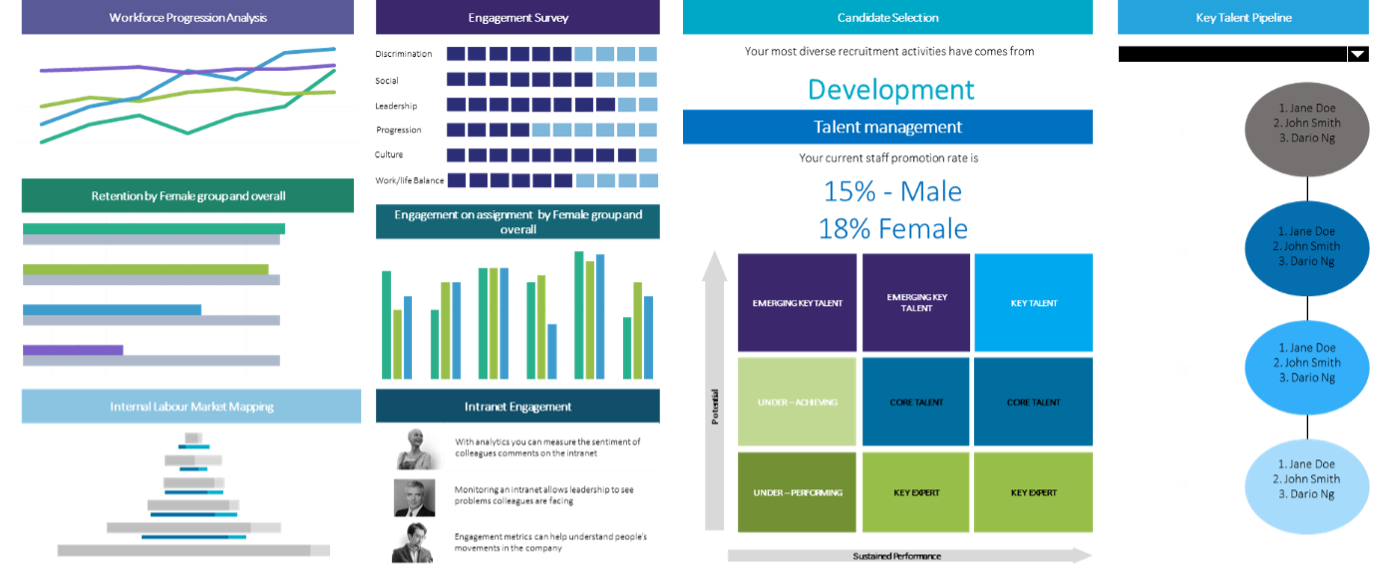Moving talent between jobs and between geographies plays a key role in fostering diversity, equity and inclusion, and HR teams should be at the forefront in the fight to develop a diverse workforce.
Mercer’s view: An evidence-based approach to inclusive mobility practices may be the key

Diagnose
Root your strategy in proof, data, and analytics.

Engage
Create an aligned and committed workforce and leaders.

Take Action
Integrate DEI into policies, practices, and programs.

Accountability
Set goals, measure progress, and share transparently.
Diagnose: understanding current state culture
Data
Workforce Progression Analysis
- Evolution of careers of former assignees
- Insights into employees promoted faster, those who have left the company and employees seeing a stalling in their career
Pay Progression Analysis
- Significant pay distortion may be due to the types of assignment pay package used over time
- A lack of pay parity could also be a symptom of unconscious bias and might result in underperformance
Employee Voice
- Measured during assignment, upon return, or after return.
- Topics include: perception of mobility; links to career progression; inclusion within local teams.
Policies and Practices
- Policy content: Is the policy relevant for all employee groups?
- Gaps: Are there gaps in terms and conditions, benefits and overall guidelines?
- What degree of flexibility should be introduced to meet the specific needs of some employee group?
Policy Review
- These things are going well.
- Here are some gaps.
- We have actionable recommendations.
Engage: starting the conversation
Engage your executive teams through awareness and collaboration sessions. See a sample scenario below:
| Estimated time |
Activity/Topic |
Objective/Content |
|
Part 1: setting the stage
|
|
15 min.
|
Introductions/Meeting objectives
|
Establish clear purpose and outcomes; ideally, the session would be kicked off with a leadership message from the CEO or another senior leader.
|
|
30 min.
|
Setting the stage: Why this matters now
|
Create awareness of potential business impacts (negative and positive) of dysfunctional corporate behaviors, in terms of financial, people and reputational impacts.
Facilitated conversation: what are the specific benefits / ROI / risks to the organization (to form the basis for the business case exercise later in the session)? Where are areas the organization could do a better job in managing cultural risks?
|
|
45 min.
|
Leaders matter
|
Participants understand their unique role as leaders in driving culture/behavior change and feel comfortable sharing/discussing POV on sensitive topics:
- Acknowledge complex position of white males in corporate culture, with emphasis on their critical role as change agent
- Discuss why diversity without inclusion doesn’t cut it
- Explore how leaders can support allyship
Facilitated conversation: what are the specific challenges and opportunities at the organization that need to be transparently identified/discussed?
|
|
Part 2: taking action
|
|
90 min.
|
What actions can you take?
|
Participants understand what role they can play as leaders, managers, and bystanders;
We will facilitate this section using a combination of group voting and multiple role playing scenarios to give participants an opportunity to personally understand/experience each scenario. After each scenario, we will brainstorm with participants to determine how the learnings/insights apply at the organization.
|
|
45 min.
|
Confirming commitment
|
Reflecting on session learnings and insights, participants will collaborate to develop the business case of how D&I contributes to the business (e.g. growth, innovation, engagement, collaboration) success of the organization.
Participants will also be asked to identify (and share, appropriate) their personal commitments to being a change champion within their respective organizations.
|
Prepare your HR and people managers to implement and support the mobility and DEI Strategy.

Key DEI terms and definitions

Overview of today's DEI climate

Common workplace micro-agressions

Leading difficult race conversations

Company programs and resources

Resources for self-learning
Take action
Include measures specifically for specific groups
- Diversity made explicit in policy
- Allowances for single parents
- Special support for older expatriates
- Provide support and detail for specific sexual offence laws in the country
Allow flexibility in the choice or the implementation of benefits and allowances
- Give the option to repurpose an existing budget
- Allow for the opportunity for ad-hoc decisions
- Provide lump sums and let employees decide how to use them
Provide communications, cultural training and coaching
- Proactively provide resources
- Ensure awareness around host countries discrimination
- Ensure assignees have a point of contact or mentor that is familiar with diversity issues and could also act as a role model
DEI should be the DNA in all aspects of the candidate experience.

Ensure accountability with metrics
Set goals, measure progress, and share transparently. If it doesn’t get measured, it doesn’t get done! To help ensure your organization is achieving its DEI goals, you need to identify what governance looks like, whether there is a process in place to revisit initiatives, and how best to progress.
One way to foster accountability is to track diversity of the assignee population, including candidate selection and offer acceptances, and to analyze whether candidates are being offered the right opportunities.
